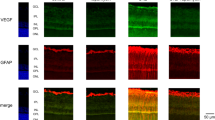Abstract
To explore the effect of high glucose concentration on the expression of vascular endothelial growth factor (VEGF) and pigment epithelium derived factor (PEDF) in the cultured rat retinal Müller cells. Rat Müller cells were cultured and RT-PCR and Western-blot analysis were used to measure the levels of VEGF and PEDF in cultured Müller cells at different high glucose concentrations. Under 10, 20, 30 mmol/L high glucose conditions, the levels of VEGF mRNA and protein increased and the levels of PEDF mRNA and protein decreased. These results suggest that the VEGF and PEDF expression in Müller cells are unbalance under high glucose concentration, which contribute to retinal neovascularization in diabetic retinopathy.




Similar content being viewed by others
References
Dvorak HF (2000) VPF/VEGF and the angiogenic response. Semin Perinatol 1:75–78. doi:10.1016/S0146-0005(00)80061-0
Tombran-Tink J (2003) Therapeutic prospects for PEDF: more than a promising angiogenesis inhibitor. Trends Mol Med 9:244–250. doi:10.1016/S1471-4914(03)00074-1
Lange J, Yafai Y, Reichenbach A (2008) Regulation of pigment epithelium-derived factor production and release by retinal glial cells under hypoxia. Invest Ophthalmol Vis Sci 11:5161–5167. doi:10.1167/iovs.08-2201
Kinkl N, Sahel J, Hicks D (2001) Alternate FGF2-ERK1/2 signaling pathways in retinal photoreceptor and glial cells in vitro. J Biol Chem 276:43871–43878. doi:10.1074/jbc.M105256200
Ohono-Matui K, Morita I, Tombran-Tink J et al (2001) Novel mechanism for age related macular degeneration: an equilibrium shift between the angiogenesis factors VEGF and PEDF. Cell Physiol 189:323–333. doi:10.1002/jcp.10026
Dieudonne SC, La Heij EC, Diederen RM (2007) Balance of vascular endothelial growth factor and pigment epithelial growth factor prior to development of proliferative vitreoretinopathy. Ophthalmic Res 39(3):148–154. doi:10.1159/000103234
Bouck N (2002) PEDF: anti-angiogenic guardian of ocular function. Trends Mol Med 8:330–334. doi:10.1016/S1471-4914(02)02362-6
Spranger J, Osterhoff M, Reimann M et al (2001) Loss of the antiangiogenic pigment epithelium-derived factor in patients with angiogenic eye disease. Diabetes 50:2641–2645. doi:10.2337/diabetes.50.12.2641
Ogata N, Nishikawa M, Nishimura T et al (2002) Unbalanced vitreous levels of pigment epithelium-derived factor and vascular endothelial growth factor in diabetic retinopathy. Am J Ophthalmol 134:348–353. doi:10.1016/S0002-9394(02)01568-4
Gao G, Li Y, Zhang D et al (2001) Unbalanced expression of VEGF and PEDF in ischemia-induced retinal neovascularization. FEBS Lett 489:270–276. doi:10.1016/S0014-5793(01)02110-X
Duh EJ, Yang HS, Suzuma I et al (2002) Pigment epithelium-derived factor suppresses ischemia-induced retinal neovascularization and VEGF-induced migration and growth. Invest Ophthalmol Vis Sci 43:821–829
Eichler W, Yafai Y, Kuhrt H et al (2001) Hypoxia: modulation of endothelial cell proliferation by soluble factors released by retinal cells. Neuroreport 12:4103–4108. doi:10.1097/00001756-200112210-00048
Wai T, Tonia S, Alberto A et al (2004) Effect of over-expression of pigment epithelium derived factor (PEDF) on developing retinal vasculature in the mouse. Mol Vis 10:837–844
Nishimura M, Ikeda T, Ushiyama M (1999) Increased vitreous concentrations of human hepatocyte growth factor in proliferative diabetic retinopathy. J Clin Endocrinol Metab 84:659–662. doi:10.1210/jc.84.2.659
Volpert OV, Zaichuk T, Zhou W (2002) Inducer-stimulated FAS targets activated endothelium for destruction by anti-angiogenic thrombospondin-1 and pigment epithelium-derived factor. Nat Med 8:349–357. doi:10.1038/nm0402-349
Eichler W, Yafai Y (2004) PEDF derived from glial Müller cells: a possible regulator of retinal angiogenesis. Exp Cell Res 299:68–78. doi:10.1016/j.yexcr.2004.05.020
Cui Y, Xu X, Bi HS (2006) Changes of reactive oxygen species in mitochondria of retinal endothelial cells and pericytes induced by high glucose. Zhonghua Yan Ke Za Zhi 42:131–138
Acknowledgments
We thank Hong-Mei Ma (Department of Ophthalmology, Harbin Medical University, Harbin, China) for expert technical assistance.
Author information
Authors and Affiliations
Corresponding author
Rights and permissions
About this article
Cite this article
Mu, H., Zhang, XM., Liu, JJ. et al. Effect of high glucose concentration on VEGF and PEDF expression in cultured retinal Müller cells. Mol Biol Rep 36, 2147–2151 (2009). https://doi.org/10.1007/s11033-008-9428-8
Received:
Accepted:
Published:
Issue Date:
DOI: https://doi.org/10.1007/s11033-008-9428-8




